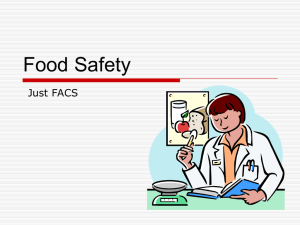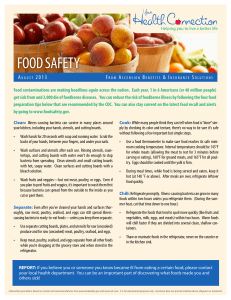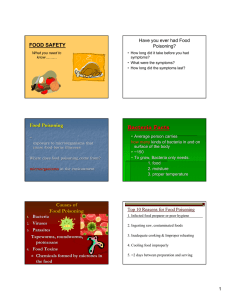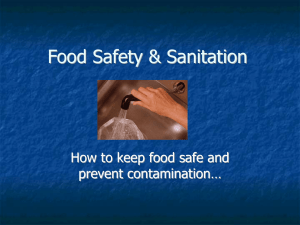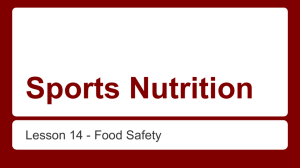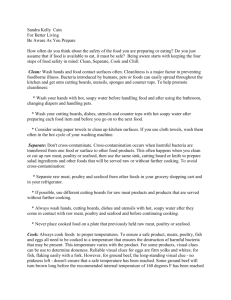FOOD SAFETY Need to Knows
advertisement
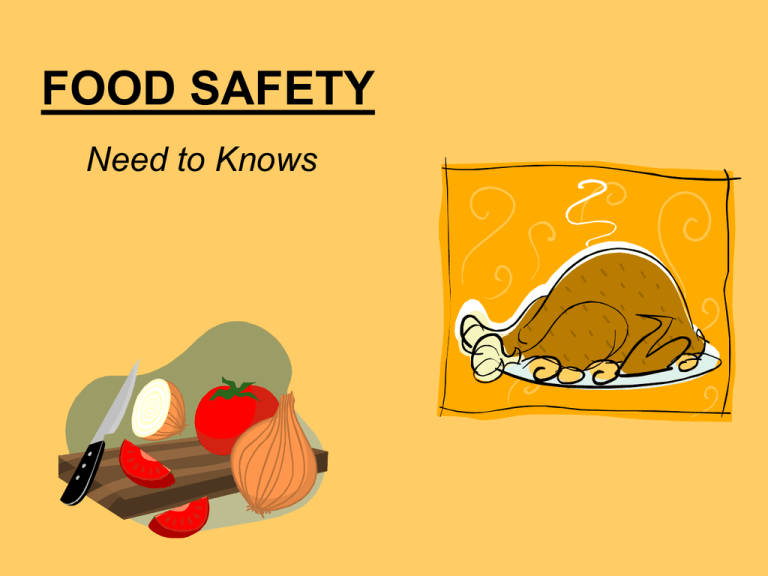
FOOD SAFETY Need to Knows F.B.I. = Foodborne Illness Generally refers to illness caused by eating any type of microorganismcontaminated food “Food Poisoning” – usually exposure to microorganisms that cause F.B.I. Comes from bacteria, viruses or other microorganisms in the environment Bacteria Facts Average person carries ~150 kinds of bacteria in and on surface of the body Bacteria can spread quickly and easily, requiring only food, moisture, and a good temperature to grow Categories of F.B.I. Agents/Contaminants Bacteria Viruses Parasites Found in untreated water & human feces Tapeworms, roundworms, protozoans Food Toxins Chemicals formed by microbes stored in food stored at improper temperatures Top 10 Reasons for F.B.I. 1. Infected food preparer or poor hygiene 2. Ingesting raw, contaminated foods 3. Inadequate cooking & Improper reheating 4. Cooling food improperly 5. >2 days between preparation and serving Top 10 Reasons for F.B.I. 6. Cross-contamination 7. Toxins (chemical contamination) 8. Unsafe food sources (i.e. meat not inspected by the USDA) 9. Inadequate cleaning of equipment 10. Poor storage practices Ideal Conditions for Bacterial Growth Food (protein) Acid (ideal acidity = pH >4.6) Temperature (“Danger Zone” = 41o F – 140o F) Time Oxygen Moisture F.A.T. T.O.M. Combined, these conditions lead to rapid growth. Food/Cooking Tips • Dry foods last longer (no moisture for growth) – Bread, dried meat, dried fruit • Adding salt and sugar decreases available water • Very acidic food is inhospitable (pH <4.6) Temperature Requirements Minimum Cooking Temps: Poultry, Stuffed & Reheated foods= 165o F Ground beef= 155o F Pork & pork-containing products= 155o F Game meat= 155o F Eggs & Fish= 145o F Cooked Fruit & Veggies= 140o F Rare Roast beef= 130o F (155o F) http://www.metrokc.gov/health/foodsfty/foodtemps.htm Temperature Requirements Foods cooked in a microwave must be heated to an additional 25o F above required cooking temperature Reheating Foods must be rapidly reheated to 165o F, then held at or above 140o F Microwaved= rapidly reheated to 190o F, then held at/above 140o F Temperature Requirements Cooling: Foods must be cooled from 140 to 70o F within two (2) hours from start of cooling Foods must be cooled from 70 to 41o F within another two (2) hours Prevention of Cross Contamination 1. Wash your hands!! 2. Wash foods 3. Clean & sanitize food contact surfaces 4. Avoid contact between foods and contact surfaces Food Storage Refrigeration Reduces growth of most organisms Freezing H2O in the form of ice – is unavailable for biological rxns Hazards – Bacteria (common) • Escherichia coli • Undercooked meat or unwashed produce, not washing hands, consumption of infected sprouts, spinach, lettuce, salami, unpasteurized milk or juice, drinking untreated water • Staphylococci • Contamination from skin Hazards – Bacteria (common) • Salmonella • • • Found in eggs, beef, poultry, milk & vegetables, cross-contamination, not washing produce, inadequate cooking Usually from foods contaminated w/ animal feces Severe infection possibly fatal • Clostridium perfringens • Improper cooling = food temps. in the “Danger Zone” Hazards – Bacteria (common) • Bacillus cereus • Improper cooling = food temps. in the “Danger Zone” • Clostridium botulinum • Improperly canned foods • Bacteria produce a nerve toxin • Spores have been found in honey DON’T feed honey to children <1 year old Hazards – Viruses (common) • Norovirus • Poor hygiene = Fecal to oral contaminant • A very hardy virus – hard to disinfect surfaces • Famous for cruise-ship epidemics Symptoms of F.B.I. • Gastroenteritis (GI) = the “stomach flu” – Nausea – Diarrhea – almost always a symptom of any F.B.I. – Abdominal cramps • • • • • • • • Sudden onset of vomiting Fever Dizziness, headaches Double or blurred vision Difficulty swallowing Dry mouth Droopy eyelids Muscle weakness 10 Food-Handling Tips to Prevent F.B.I. 1. Don’t buy cans or glass jars with dents, cracks or bulging lids. 2. Never eat raw meat, poultry, seafood or eggs. 3. Cook raw meat, poultry, seafood or eggs thoroughly to kill any bacteria present. Thoroughly reheat leftovers. 4. Promptly refrigerate cooked meat and poultry in small shallow containers. Remove stuffing from chicken and turkey and refrigerate separately. 5. Refrigerate perishable food as soon as you get home from the market. 10 Food-Handling Tips to Prevent F.B.I. 6. Store canned goods in a cool, dry place for use within a year. Never put them above the oven or in a damp area. 7. Don’t thaw food on the counter; bacteria grow quickly at room temperature. Thaw food in the refrigerator or in the microwave just before cooking. 8. Keep work areas clean. Wash hands, utensils and cutting boards in hot soapy water before preparing food and after handling raw meat or poultry. 9. Use a plastic or other nonporous cutting board. 10. Keep pets away from the food, cooking and eating surfaces, and equipment. Don’t Take Chances • If you suspect there’s a problem, throw the food out. • WHEN IN DOUBT, THROW IT OUT!!
